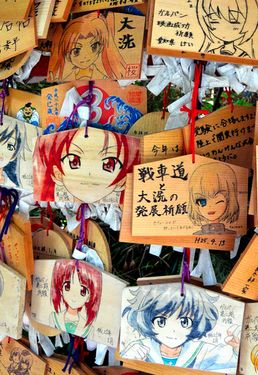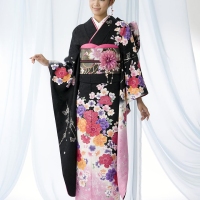Anime enthusiasts are flocking in droves to Shinto shrines and Buddhist temples, but not in a spiritual pilgrimage or prompted by a sudden interest in religion.
Instead it’s worship of a different kind, a devotion to fictional characters from their beloved animated works. At the shrines and temples, these anime buffs are dedicating mountains of votive picture tablets, called “ita-ema,” containing drawings of their favorite characters.
On one weekend in July, an incessant wave of young visitors was seen at Oarai Isosakijinja shrine, which overlooks the Pacific Ocean in Oarai, Ibaraki Prefecture.
After praying at the worship hall, the young “pilgrims” made frequent stops at a nearby area that was offering picture tablets for sale, where hand-drawn images of young girls far outnumber the usual tablets, which typically carry prayers about entrance exams and love.
“Katyusha is here,” said one excited visitor, who had spotted an image of one fictional character. “Wow, there are so many,” exclaimed another, merrily photographing the magnificent spectacle.
“Girls und Panzer,” an anime set in Oarai, was aired from October through March. Themed around sports and youth, the serial work centered on high school girls in tanks battling as a martial art.
Views of the town, including of the shrine, were reproduced with precision in scenes of the anime that depicted the street fighting, part of the combative “bouts.”
One male visitor from Ushiku, Ibaraki Prefecture, said he has dedicated more than 30 picture tablets of his own drawings.

“It’s fun, because some people learn about my tablets on the Internet and come to see them,” said the 31-year-old. He said he makes a point of adding one phrase to his drawings: “For the development of Oarai.”
“I like the atmosphere here, so I hope the passion will continue,” the man said.
A shrine official spoke approvingly of the recent wave of visiting anime enthusiasts.
“They are real master illustrators,” he said. “I was surprised at the outset, but I am grateful for them, because they do care about Oarai.”
The word itaema, which has taken root among anime followers, was coined after “ita-sha,” which refers to cars carrying flamboyant paintings of fictional characters from the owners’ favorite anime or video games. That style of expression is believed to have originated from Washinomiyajinja shri
ne in Saitama Prefecture, where “Lucky Star,” a popular anime series from 2007, was set.
“It represents one form of fan culture, whereby you leave behind proof of your visits for others to see, much like you do in cosplay,” said Takeshi Okamoto, a lecturer of tourism sociology at Nara Prefectural University, who is studying the “pilgrimage” of anime enthusiasts.
Each shrine designates a special area for visitors to offer their votive picture tablets. That makes it easier to see that many fans are visiting, so the inspired enthusiasts compete to draw more votive tablets, offering more visual fun to their fellow anime fans, Okamoto said.
Jorinji temple, a stop on the traditional, 34-temple pilgrimage route in the Chichibu area of Saitama Prefecture, was featured in “Anohana: The Flower We Saw That Day,” a serial anime aired in 2011. A feature film version has been showing in theaters across Japan since late August.
Jorinji sells official votive tablets that each carry an image of a female character in the work. While many “Anohana” enthusiasts buy them to take home, a large number of them dedicate the tablets to the temple after adding their own drawings and messages to the blank sections.
Hiroya Yoshitani, a professor of religious folklore at Komatsu College, studied 635 votive picture tablets that were offered on the temple grounds in February. He found that 24 percent of them carried conventional types of prayers, such as for success in exams, whereas an additional 25 percent carried prayers about developments in “Anohana,” such as luck in love for fictional characters in the anime.
What drew Yoshitani’s attention were the unconventional “novel” types of prayers that were carried by many of the remaining half of the votive tablets. One said, “May happiness prevail on everybody who comes here,” whereas another said, “May peace prevail in the world,” Yoshitani said.
“Anohana” was aired in the immediate aftermath of the Great East Japan Earthquake and tsunami, which claimed more than 15,000 lives. It features a girl who dies in an accident and later returns to her childhood friends. That storyline probably inspired the novel types of prayers, Yoshitani said.
Something similar is found at Oarai Isosakijinja shrine of the “Girls und Panzer” fame, where many votive tablets carry prayers about recovery from the disasters of March 11, 2011. Oarai not only had its coastal areas swamped by the towering tsunami, but the town has also been plagued by harmful rumors about radioactive fallout from the Fukushima nuclear disaster, which followed the March 2011 earthquake.
“Votive picture tablets are typical examples of worldly desires, which are egotistic,” Yoshitani said. “But fictional works with the power to inspire have engendered altruistic and all-embracing prayers that go beyond personal yearnings.”











